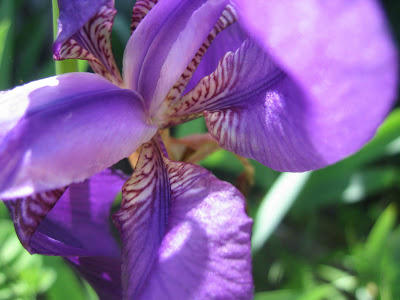 Irises were one of the first things I planted. I saw them struggling in a forgotten corner of
Irises were one of the first things I planted. I saw them struggling in a forgotten corner ofthe property, almost suffocated by wild grass, dug them up and replanted them. Mindful of
the trauma they might have suffered at the hands of the couch grass,
I try my best to keep their plot weed-free.
One immediate thing that comes to mind, especially since it is spring and the flowers have begun blooming, is my dry garden.
I can spend hours working there, weeding the iris plot, fixing up the santolinas' water holes, trimming the Frankenia laevis that's been creeping up over the stepping stones. And yet, up until a few years ago, as I had lived in apartments most of my adult life, I knew absolutely nothing about gardening. My family would always say that I was the only girl they knew who could kill a potted cactus.
Then my husband and I moved to a space where there was nothing but land. No manicured lawns here, though, rather pesky couch grass, thorny wild raspberries, and, since we live near marshes, almost-impossible-to-get-rid-of reeds.
I suppose it was just my nature to want to make things better. Of course, the first year was an absolute disaster. I went to the garden shop, picked up just whatever I thought was pretty, and plonked those into holes, not realizing that there were things to consider such as soil pH levels, the harshness of the winds, even the amount of saltiness in the air! As you can guess, most of my plants from that season died.
 My carboprotus. I planted them before I knew that they can become wildly invasive.
My carboprotus. I planted them before I knew that they can become wildly invasive.Now I pay very close attention to how I discard the leaves after a trimming
I remember having a conversation once with Tony Leano, a Filipino artist with a green thumb, and him telling me that a big part of gardening is observing. You watch the plants, and you learn from them. Well that I did, but since I am more nerd than Zen Yoda master, I also did buy countless books on what plants succeed in dry conditions.
 Cistus florentinus. This plant was chosen when I knew a little bit more,
Cistus florentinus. This plant was chosen when I knew a little bit more, and picked because it tolerates alkalinity well and can grow in partial shade.
Now that my first dry garden is going on two years old (and most of the plants still alive -- thank goodness!), I've begun a second one. So, Caitlin, on page one of my virtual inspiration notebook: two rectangles of earth.




















